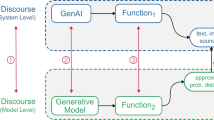Abstract
The closed systems of contemporary Artificial Intelligence do not seem to lead to intelligent machines in the near future. What is needed are open-ended systems with non-linear properties in order to create interesting properties for the scaffolding of an artificial mind. Using post-structuralistic theories of possibility spaces combined with neo-cybernetic mechanisms such as feedback allows to actively manipulate the phase space of possibilities. This is the field of Generative Artificial Intelligence and it is implementing mechanisms and setting up experiments with the goal of the creation of open-ended systems. It sidesteps the traditional argumentation of top-down versus bottom-up by using both mechanisms. Bottom-up procedures are used to generate possibility spaces and top-down methods sort out the structures that are functioning the worst. Top-down mechanisms can be the environment, but also humans who steer the development processes.
Access this chapter
Tax calculation will be finalised at checkout
Purchases are for personal use only
Preview
Unable to display preview. Download preview PDF.
Similar content being viewed by others
References
Adriaans, P., van Zaanen, M.: Computational Grammar Induction for Linguists. Special issue of the Journal “Grammars” with the Theme “Grammar Induction” 7, 57–68 (2004)
Arbib, M.A.: The Handbook of Brain Theory and Neural Networks, 2nd edn. MIT Press, Cambridge (2002)
Bogard, W.: Book Review: How the Actual Emerges from the Virtual. International Journal of Baudrillard Studies 2(1) (2005)
Bonta, M., Protevi, J.: Deleuze and geophilosophy: a guide and glossary. Edinburgh University Press, Edinburgh (2004)
Boser, B.E., Guyon, I.M., Vapnik, V.N.: A training algorithm for optimal margin classifiers. In: Haussler, D. (ed.) 5th Annual ACM Workshop on COLT, pp. 144–152. ACM Press, Pittsburgh (1992)
Brooks, R.: A robust layered control system for a mobile robot. IEEE Journal of Robotics and Automation (1986)
Clark, A.: Natural-Born Cyborgs: Minds, Technologies, and the Future of Human Intelligence. Oxford University Press (2003)
DeLanda, M.: War in the Age of Intelligent Machines. Zone Books, New York (1991)
DeLanda, M.: Intensive Science and Virtual Philosophy. Continuum, London (2002)
DeLanda, M.: Ecology and Realist Ontology. In: Herzogenrath, B. (ed.) Deleuze/Guattari & Ecology, pp. 23–41. Palgrave Macmillan, London (2009)
DeLanda, M.: Philosophy and Simulation: The Emergence of Synthetic Reason. Continuum, London (2011)
Deleuze, G.: Difference and Repetition. Translated by Paul Patton. Continuum, London (2004)
Deleuze, G., Guattari, F.: A thousand plateaus: capitalism and schizophrenia. Translated by Brian Massumi. Continuum, London (2004)
Elman, J., et al.: Rethinking Innateness: A connectionist perspective on development, Bradford. MIT Press, Cambridge (1996)
Gaffney, P.: The Force of the Virtual. University of Minnesota Press, Minneapolis (2010)
Grey, W.: An imitation of life, pp. 42–45. Scientific American (1950)
Hendriks-Jansen, H.: Catching Ourselves in the Act: Situated Activity, Interactive Emergence, Evolution, and Human Thought. MIT Press, Cambridge (1996)
Koza, J.R.: Hierarchical genetic algorithms operating on populations of computer programs. In: Proceedings of the Eleventh International Joint Conference on Artificial Intelligence IJCAI 1989, vol. 1, pp. 768–774 (1989)
Rabiner, L.R.: A tutorial on Hidden Markov Models and selected applications in speech recognition. Proceedings of the IEEE 77(2), 257–286 (1989)
Meillassoux, Q.: After Finitude. An Essay on the Necessity of Contingency. Continuum, London (2008)
Mitchell, T.M.: Generalization as search. Artificial Intelligence 18(2), 203–226 (1982)
Mitchell, T.M.: Machine learning. McGraw-Hill, Boston (1997)
Kirkpatrick, S., Gelatt, C.D., Vecchi, M.P.: Optimization by Simulated Annealing. Science 220(4598), 671 (1983)
Polanyi, M.: The Tacit Dimension. First published Doubleday & Co. (1966); Reprinted Peter Smith, ch. 1: “Tacit Knowing”, Gloucester, Mass (1983)
Prigogine, I., Stengers, I.: Order out of Chaos: Man’s new dialogue with nature. Flamingo, London (1984) ISBN 0006541151
Rabiner, L.R.: A tutorial on hidden Markov models and selected applications in speech recognition. Proc. IEEE 77(2), 257–286 (1989)
Shafer, G., Pearl, J. (eds.): Probabilistic Reasoning in Intelligent Systems. Morgan Kaufmann, San Mateo (1988)
Simon, H.A.: The Sciences of the Artificial, 1st edn. MIT Press, Cambridge (1969)
Werbos, P.J.: Beyond Regression: New Tools for Prediction and Analysis in the Behavioral Sciences. PhD thesis, Harvard University (1974)
van der Zant, T., Schomaker, L., Haak, K.: Handwritten-word spotting using biologically inspired features. IEEE Transactions on Pattern Analysis and Machine Intelligence 30(11), 1945–1957 (2008b)
van der Zant, T.: Generative AI: a neo-cybernetic analysis. PhD thesis, University of Groningen (2010) ISBN 978-90-367-4470-6
Varela, F.J., Thompson, E.T., Rosch, E.: The Embodied Mind: Cognitive Science and Human Experience. MIT Press (1992)
Author information
Authors and Affiliations
Corresponding author
Editor information
Editors and Affiliations
Rights and permissions
Copyright information
© 2013 Springer-Verlag GmbH Berlin Heidelberg
About this chapter
Cite this chapter
van der Zant, T., Kouw, M., Schomaker, L. (2013). Generative Artificial Intelligence. In: Müller, V. (eds) Philosophy and Theory of Artificial Intelligence. Studies in Applied Philosophy, Epistemology and Rational Ethics, vol 5. Springer, Berlin, Heidelberg. https://doi.org/10.1007/978-3-642-31674-6_8
Download citation
DOI: https://doi.org/10.1007/978-3-642-31674-6_8
Publisher Name: Springer, Berlin, Heidelberg
Print ISBN: 978-3-642-31673-9
Online ISBN: 978-3-642-31674-6
eBook Packages: EngineeringEngineering (R0)




